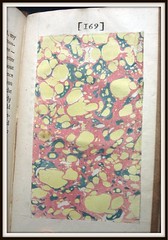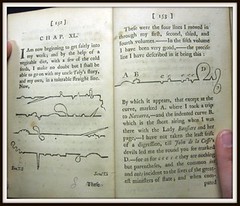
This blog entry is the second in a series dedicated to showcasing our current exhibit, Eighteenth-Century Book Illustration, which can be viewed in the Reading Room until the middle of this semester. Today we will focus on our display of Laurence Sterne’s The Life and Opinions of Tristram Shandy, Gentleman, which features representative volumes from three sets of the novel.
Laurence Sterne’s (1713-1768) duties as an Anglican priest in a rural parish occupied the majority of his life. He only became known as a recognizable public figure after the publication of Tristram Shandy, which was written during his final years. Sterne published each volume as it was completed over the course of eight years (1759-1767).

Despite Sterne’s lengthy clerical career, Tristram Shandy abounds in bawdy humor and satirical wit. Further, it displays Sterne’s notable creativity. Tristram Shandy is ostensibly the title character’s account of his life, but Tristram frequently engages in lengthy digressions about numerous topics, to the point where the narrative actually contains very few details of Tristram’s life.
In addition to a unique narrative structure, Sterne embedded images within Tristram Shandy that are inseparable from the text of the novel, an uncommon practice for an eighteenth-century author. Our display shows four examples of Sterne’s technique: a page that is colored black entirely, which appears after Tristram describes the death of Parson Yorick; the marbled page that Tristram explains is a “motley emblem of [his] work”; Tristram’s visualization of the sequence of his narrative, which includes a number of curiously shaped lines; and Corporal Trim’s flourish, meant to illustrate the motion of Trim’s stick as he gesticulates in the air. These images reveal Sterne experimenting with the medium of printed text and bear a resemblance to the textual experimentation of writers from the twentieth century.


